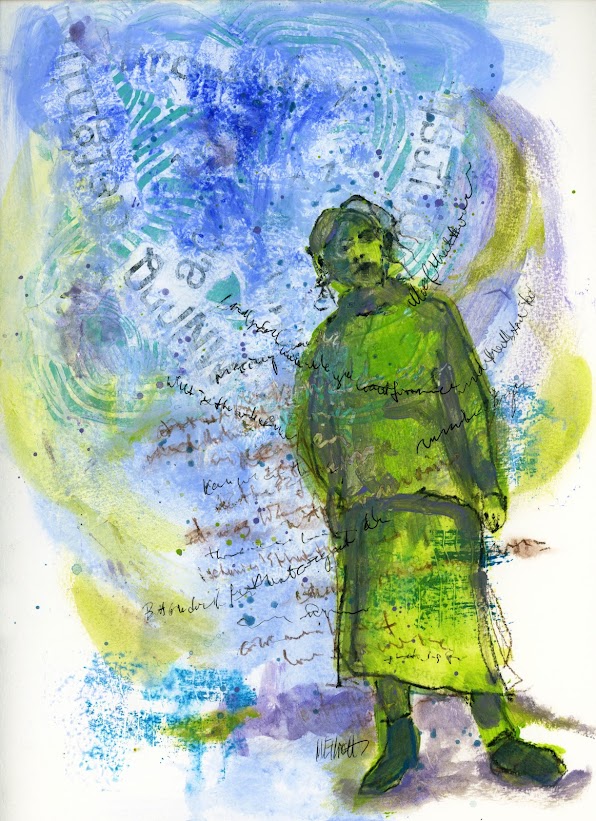Kara Bullock Studios, purveyors of great art classes including Let's Face It every year for the past eight, kindly provided a series of 10 bonus lessons as a Christmas gift for their students and, although intended only to last through Christmas Day, yielded to pleading by those of us too busy to take advantage before then and left them up the rest of this week. I finally got around to watching one of them Tuesday and yesterday, and last night I painted the background for the one that occupied most of my day today, following Holly Beals's lesson on figures and collage.
I had, for almost the first time, an experience that apparently my peers in the class have had all too frequently—I posted a question today: "Does anybody here ever start a painting whose subject you initially found compelling, only to lose interest halfway through?" The 25 answers I received were unanimously in the affirmative, the most disturbing one to me being "I have about 40 paintings you can finish off!" I now count myself lucky that this is practically the first time this has happened to me; perhaps it is luck, or perhaps I generally only choose subjects that don't disappoint...or perhaps I need to be more challenged?
That was certainly an element in this one. First of all, it was working small, in the sense that usually when I use an 11x14 board, it gets filled up by one big head, while today I was painting a scene that included two complete figures plus substantial background. I dislike working small, especially when I am painting with acrylics, because I am not the best at manipulating small brushes to get precise strokes, and get easily frustrated by what I'm picturing versus what emerges on my board.
Second, I chose to find my own reference photo instead of copying the one Holly used, but although I liked the scene, it had several challenges not included in Holly's—way more background and full figures instead of partial; plus the view was from the front instead of from the rear, so I had to deal with faces; and then there were the perspective issues, which I am notorious for avoiding because I am so bad at them. I had pinky-purple brick walls with angles, a turquoise metal pleated door set back between the walls, a platform for the figures to sit on, and people whose heads were much further away than their feet, which loom larger in the foreground. I think the "disinterest" may have been a thin disguise for dismay at having to confront all these in one picture!
Having said ALL of that...I am somewhat pleased with the outcome. The faces are not up to my standards, and a couple of the hands look distressingly paw-like, but I like the textures and colors and contrasts I achieved, and I managed to stay somewhat loose and painterly, which was part of the lesson.
Although I planned to include some collage, ultimately I chose not to fiddle with it. Unless the collage fits integrally into the picture, it seems to me such an artificial kind of thing, and this was no exception; I could choose to rip and tear some bricks, or I could just give an impression of them with paint, and I went with the paint. Part of the problem, also, is that I don't have very many nice collage elements from which to choose, so there's that.
Anyway, enough with the talking. This is on cradleboard, another new experience, and this one I liked. You carry elements of the painting around to the edges of your one-inch-deep board, and you have a finished box you can hang on the wall without a frame. I will be doing more of that!
I'm calling it "Break." It's acrylics on cradleboard, 14x11 inches (plus wraparound).









































